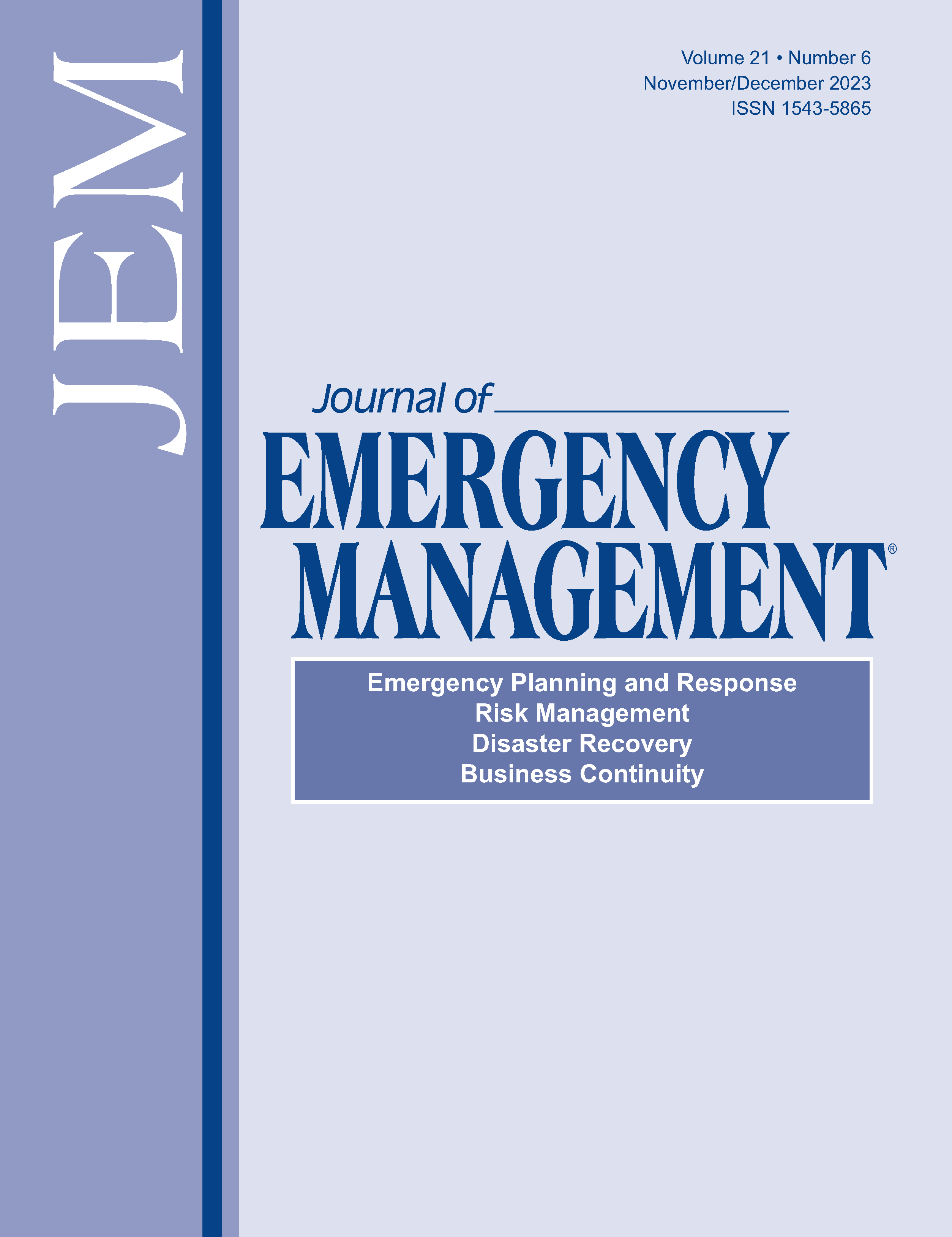Coping with COVID-19: Standing up a comprehensive behavioral health response to the pandemic
DOI:
https://doi.org/10.5055/jem.0783Keywords:
disaster behavioral health, behavioral health response, emergency responseAbstract
Integrating behavioral health (BH) into disaster preparedness and response is essential to mitigate and address the BH impacts of disasters, support incident response personnel well-being, and to integrate disaster BH concepts into response strategies and communications. This article describes the development, implementation, and lessons learned from a statewide BH response to this disaster by the COVID-19 Behavioral Health Group (COVID-19 BHG). Operating within the Washington State Department of Health (WA DOH), the BHG is comprised of psychologists and psychiatrists with expertise in disaster BH and response, BH epidemiologists, data analysts, systems specialists, emergency managers, and other DOH staff. The wide array of expertise on the team allowed the COVID-19 BHG to build response functions to match the demands created by the pandemic. This included an Impact & Capacity Assessment function, which developed and distributed monthly impact forecasts and weekly BH situational reports. A Training and Guidance team then collaborated with partners to develop and deliver trainings, resource documents, and public messaging. Additionally, the COVID-19 BHG worked closely with the Health Care Authority (HCA) and BH organizations statewide to maintain the ability of the BH system to deliver care and expand services to meet additional needs. This article describes the development and deployment of an innovative and unique statewide BH response, within the WA DOH during the COVID-19 pandemic.
References
Kennedy M, Gonick SA, Errett NA: Are we ready to build back “healthier?” An exploratory analysis of US state-level disaster recovery plans. Int J Environ Res Public Health. 2021; 18(15): 8003. DOI: 10.3390/ijerph18158003.
Soklaridis S, Lin E, Lalani Y, et al.: Mental health interventions and supports during COVID-19 and other medical pandemics: A rapid systematic review of the evidence. Gen Hosp Psychiatr. 2020; 66: 133-146. DOI: 10.1016/j.genhosppsych.2020.08.007.
State of Hawaii Department of Health: Department of Health Highlights Youth-Focused Empowerment Resources with Public Awareness Campaign. Available at https://health.hawaii.gov/news/newsroom/department-of-health-highlights-youth-focused-empowerment-resources-with-public-awareness-campaign/. Accessed November 22, 2022.
Bartels S, Baggett T, Freudenreich O, et al.: COVID-19 emergency reforms in Massachusetts to support behavioral health care and reduce mortality of people with serious mental illness. Psychiatr Serv. 2020; 71(10): 1078-1081. DOI: 10.1176/appi.ps.202000244.
Shim RS, Starks SM: COVID-19, structural racism, and mental health inequities: Policy implications for an emerging pandemic. Psychiatr Serv. 2021; 72(10): 1193-1198. DOI: 10.1176/appi.ps.202000725.
Lockard RA, Priest KC, Brown, et al.: Addressing a rapidly changing service landscape during the COVID-19 pandemic: Creation of the Oregon substance use disorder resource collaborative. J Subs Abuse Treat. 2021; 124: 108244. DOI: 10.1016/j.jsat.2020.108244.
Katzman JG, Tomedi LE, Thornton K, et al.: Innovative COVID-19 programs to rapidly serve New Mexico. Public Health Rep. 2021; 136(1): 39-46. DOI: 10.1177/0033354920969180.
RÇdulescu A, Ballard S, Gonzalez K, et al.: Dynamic coupling between the COVID-19 epidemic timeline and the behavioral response to PAUSE in New York state counties. PLoS ONE. 2021; 16(8): e0255236.
Statewide high-level analysis of forecasted behavioral health impacts from COVID. Available at https://www.doh.wa.gov/Portals/1/Documents/1600/coronavirus/821-136-StatewideBehavioralHealthForecastSummary-April2021.pdf. Accessed May 24, 2021.
Substance Abuse and Mental Health Services Administration: Supplemental Research Bulletin—Issue 5: Traumatic Stress and Suicide after Disasters. Rockville, MD: SAMHSA, 2015.
Centers for Disease Control and Prevention: The continuum of pandemic. CDC. 2018. Available at https://www.cdc.gov/flu/pandemicresources/planning-preparedness/global-planning-508.html. Accessed May 4, 2021.
COVID-19 behavioral health impact situation report: Available at https://www.doh.wa.gov/Portals/1/Documents/1600/coronavirus/821-102-BehavioralHealthImpactReport-05102021.pdf. Accessed May 24, 2021.
Health Support Team: Available at http://healthsupportteam.org. Accessed May 24, 2021.
Schreiber MD, Yin R, Omaish M, et al.: Snapshot from superstorm sandy: American Red Cross mental health risk surveillance in lower New York State. Ann Emerg Med. 2014; 64(1): 59-65. DOI: 10.1016/j.annemergmen.2013.11.009.
Schreiber M, Cates DS, Formanski S, et al.: Maximizing the resilience of healthcare workers in multi-hazard events: Lessons from the 2014-2015 Ebola response in Africa. Milit Med. 2019; 184(3/4): 114-120.
Sylwanowicz L, Schreiber M, Anderson C, et al.: Rapid triage of mental health risk in emergency medical workers: Findings from Typhoon Haiyan. Disaster Med Public Health Prepared. 2018; 2(1): 19-22. DOI: 10.1017/dmp.2017.37.
Western Regional Alliance for Pediatric Emergency Management: Available at https://wrap-em.org/index.php. Accessed May 24, 2021. 18. Northwest Healthcare Response Network: Available at https://nwhrn.org. Accessed May 24, 2021.
Published
How to Cite
Issue
Section
License
Copyright 2007-2025, Weston Medical Publishing, LLC and Journal of Emergency Management. All Rights Reserved.






